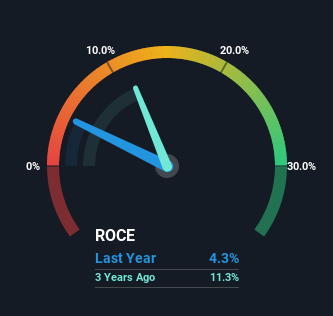- Chile
- /
- Electric Utilities
- /
- SNSE:ENELCHILE
Here's What's Concerning About Enel Chile's (SNSE:ENELCHILE) Returns On Capital

If you're looking for a multi-bagger, there's a few things to keep an eye out for. Firstly, we'll want to see a proven return on capital employed (ROCE) that is increasing, and secondly, an expanding base of capital employed. This shows us that it's a compounding machine, able to continually reinvest its earnings back into the business and generate higher returns. In light of that, when we looked at Enel Chile (SNSE:ENELCHILE) and its ROCE trend, we weren't exactly thrilled.
Return On Capital Employed (ROCE): What Is It?
If you haven't worked with ROCE before, it measures the 'return' (pre-tax profit) a company generates from capital employed in its business. To calculate this metric for Enel Chile, this is the formula:
Return on Capital Employed = Earnings Before Interest and Tax (EBIT) ÷ (Total Assets - Current Liabilities)
0.043 = CL$334b ÷ (CL$12t - CL$3.9t) (Based on the trailing twelve months to September 2022).
Thus, Enel Chile has an ROCE of 4.3%. In absolute terms, that's a low return and it also under-performs the Electric Utilities industry average of 14%.
Check out the opportunities and risks within the CL Electric Utilities industry.

In the above chart we have measured Enel Chile's prior ROCE against its prior performance, but the future is arguably more important. If you'd like to see what analysts are forecasting going forward, you should check out our free report for Enel Chile.
So How Is Enel Chile's ROCE Trending?
On the surface, the trend of ROCE at Enel Chile doesn't inspire confidence. To be more specific, ROCE has fallen from 13% over the last five years. However, given capital employed and revenue have both increased it appears that the business is currently pursuing growth, at the consequence of short term returns. If these investments prove successful, this can bode very well for long term stock performance.
On a side note, Enel Chile's current liabilities have increased over the last five years to 34% of total assets, effectively distorting the ROCE to some degree. Without this increase, it's likely that ROCE would be even lower than 4.3%. While the ratio isn't currently too high, it's worth keeping an eye on this because if it gets particularly high, the business could then face some new elements of risk.
What We Can Learn From Enel Chile's ROCE
While returns have fallen for Enel Chile in recent times, we're encouraged to see that sales are growing and that the business is reinvesting in its operations. These growth trends haven't led to growth returns though, since the stock has fallen 30% over the last five years. So we think it'd be worthwhile to look further into this stock given the trends look encouraging.
One more thing: We've identified 3 warning signs with Enel Chile (at least 1 which doesn't sit too well with us) , and understanding these would certainly be useful.
For those who like to invest in solid companies, check out this free list of companies with solid balance sheets and high returns on equity.
Valuation is complex, but we're here to simplify it.
Discover if Enel Chile might be undervalued or overvalued with our detailed analysis, featuring fair value estimates, potential risks, dividends, insider trades, and its financial condition.
Access Free AnalysisHave feedback on this article? Concerned about the content? Get in touch with us directly. Alternatively, email editorial-team (at) simplywallst.com.
This article by Simply Wall St is general in nature. We provide commentary based on historical data and analyst forecasts only using an unbiased methodology and our articles are not intended to be financial advice. It does not constitute a recommendation to buy or sell any stock, and does not take account of your objectives, or your financial situation. We aim to bring you long-term focused analysis driven by fundamental data. Note that our analysis may not factor in the latest price-sensitive company announcements or qualitative material. Simply Wall St has no position in any stocks mentioned.
About SNSE:ENELCHILE
Enel Chile
An electricity utility company, engages in the generation, transmission, and distribution of electricity in Chile.
Reasonable growth potential with adequate balance sheet.
Market Insights
Community Narratives




